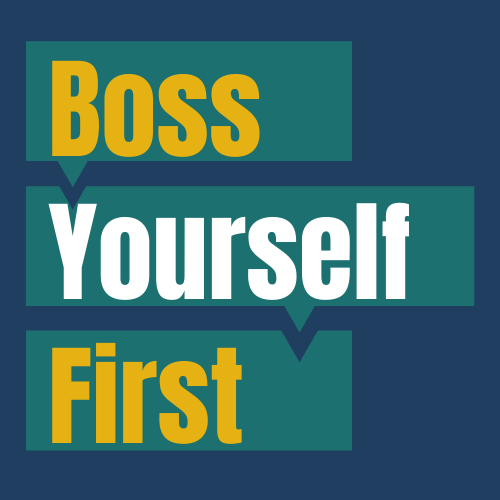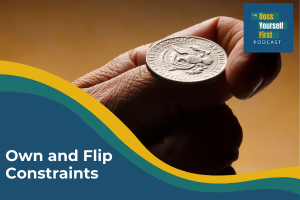Own and Flip Constraints
On today’s episode, we look at a simple but powerful technique to quickly process constraint. Learn to own your constraint and then flip it to generate creative and motivating energy. We also take a peek into Laura Huang’s excellent book, Edge: Turning Adversity into Advantage. Don’t miss this short and powerful episode!
Episode Transcript
Boss Yourself First –
BYF Podcast Season 2 Episode 8
As we wrap up our solo episodes of the season, I want to give you another perspective on constraint and another sort of quick hack for processing constraint. We’ve spent the last 7 weeks looking at the stages of processing constraint and tools to help us clearly identify the constraint and ask the right questions to get to innovative solutions. We’ve also looked at supporting our work by tapping into emotional motivation. Today, I want to share another simple tool for processing constraints be they physical constraints, emotional constraints, mental constraints. When we run into an obstacle that limits our movement toward our desired result, this method can help you out. And this is a method I’ve used for some time and I really didn’t think about how it applies to constraints because I usually use it with myself and clients when it comes to limiting beliefs but since limiting beliefs whether they are held by ourselves or someone else, are a form of constraint. This all came together for me back when I was first preparing for this season and I was reading a book by a Harvard Associate Professor named Laura Huang. If you haven’t heard of her yet, you will she is an up and coming thought leader and a very popular professor. Her book is called Edge, Turning Adversity into Advantage and it is an excellent read and after reading it, I can see why she is such a popular professor. Anyway, Huang writes about a particular constraint and I want to share that with you and then I’ll share the method I mentioned earlier. As a child, Huang was place in a Gifted and Talented Math program but not the reading/language arts GT program. The reason she was given was that the language arts would be too challenging for her as a non-native English speaker. This was confusing as Huang is a multi-language native speaker and one of those languages was English. However, this was a concept that her elementary teacher could not grasp. Almost 10 years after that Huang was enrolled in the required Freshman writing course at her university. She received a failing grade on her first writing assignment and went to get clarity from the instructor. His explanation had a familiar ring, “Don’t worry, since English is not your native language, it will take you some time to get the hang of writing. It will come.” Frustrated, Huang surmised that because of her last name the instructor had given her the constraint of being a non-native English speaker. Her suspicions were soon confirmed when she found another Asian student in her class had a similar experience with that instructor. Here’s where it gets really fun and leads into our discussion of today’s technique. Huang and her falsely constrained fellow student decided to grab hold of that constraint and use it. Huang says, “So we came up with a plant to “own” the constraint.” In Huang’s next essay, she frequently referenced her “nonnative English” and wrote about overcoming the challenges of overcoming this constraint. The instructor missed the sarcasm and bought further into the constraint he had set. She got a B- on the paper.
I want to share this quote from Huang’s book, Edge, she says, “ When we own constraints, magical things can happen. Indeed, when we leverage difficulties and use them as tools to propel us toward success, we start to carve out our edge. “
I want that to fall fresh on you today, no matter whether a constraint comes from an outside source or from yourself, when you leverage it as a tool, you have an advantage.
That’s what we are going to do in the next few minutes. And this is a really simple process, are you ready? You own the constraint. And I’ll share with you one of my most recent ones, I am in the second draft of my book and to be really honest, I’m struggling with motivation to go through the rewrites. So, my constraint that I’m noticing is that I have low motivation to get the work done on the book.
The next step is to flip the constraint. I’m going to repeat here just so you catch the flip.
I have low motivation to work on my book so it’s not getting done.
I am highly motivated to work so it’s going to get done.
So you caught that right? I just stated the opposite of my constraint. Now that you’ve got the flip. You ask yourself a question. This is where we take advantage of our brain’s hard-wired proclivity to answer questions. We just have to ask the right question. We make a question from our flip statement of constraint.
If I were highly motivated to work on this book, what would I be doing? And here is where you can nuance the question a little bit. Make sure your words are strong enough to trigger some answers in your mind. So, to be honest, the question I just stated didn’t generate a lot of energy for me, It didn’t really connect emotionally with me. So, I looked to amp up my question. It became – If I were obsessed with finishing this book, what would I be doing right now?
Boom! I was off to the races. If I were obsessed with finishing, I would put other projects on hold. I would let my family know that they would see a little less of me for a bit. I would put someone else in charge of dinner time. I would get my readers reading and be excited about their feedback. I would be committing to a publisher. And the list went on all the way to the condition of my desk. A writer obsessed with her book, would not let other projects clutter her workspace.
Let’s use another example that we’ve used for different techniques this season. I cannot make a profit with my restaurant with no indoor dining allowed. If we own that and flip it we’d have. I can make a profit with no indoor dining allowed. What if we wanted to amp the question? It might become, I can make more profit than ever before with no indoor dining. Then we ask ourselves the flip question? If I were making more profit than ever before, without indoor dining, what would I be doing? I’d be delivering food. I’d be making prepped meal kits to sell curbside or deliver. I’d be taking online orders for pick up.
This is a quick and powerful technique. Just be sure to get the flipped question amped up to emotional connection. You’ll know when you’ve got it because the answers will start to come and bring you a punch of energy.
The last step is to act on your ideas as soon as possible. Take the smallest, most actionable idea and make it happen as soon as you have your list generated. Get moving and you’ll get momentum.
Hey this was a quick one today, but I hope you are already thinking of some constraints to work on. I’d love to hear about your journey, you can reach me at bossyourselffirst.com or message me on Instagram or Facebook. I hope you have a fantastic week owning your constraints and flipping them for your own good purposes. Thanks for being here and take care everyone.

